Related Research Articles

Mendon is a town in Worcester County, Massachusetts, United States. The population was 5,839 at the 2010 census. Mendon is part of the Blackstone River Valley National Heritage Corridor, an early center of the industrial revolution in the United States. Mendon celebrated its 350th Anniversary on May 15, 2017.

The Quabbin Reservoir is the largest inland body of water in Massachusetts, and was built between 1930 and 1939. Along with the Wachusett Reservoir, it is the primary water supply for Boston, 65 miles (105 km) to the east, and 40 other cities and towns in Greater Boston. The Quabbin also supplies water to three towns west of the reservoir and acts as backup supply for three others. By 1989, it supplied water for 2.5 million people, about 40% of the state's population at the time. It has an aggregate capacity of 412 billion US gallons (1,560 GL) and an area of 38.6 square miles (99.9 km2).

Western Massachusetts is a region in Massachusetts, one of the six U.S. states that make up the New England region of the United States. Western Massachusetts has diverse topography; 22 colleges and universities, with approximately 100,000 students; and such institutions as Tanglewood, the Springfield Armory, and Jacob's Pillow.

Mount Wachusett is a mountain in Massachusetts. It straddles towns of Princeton and Westminster, in Worcester County. It is the highest point in Massachusetts east of the Connecticut River. The mountain is named after a Native American term meaning "near the mountain" or "mountain place". The mountain is a popular hiking and skiing destination. An automobile road, open spring to fall, ascends to the summit. Views from the top of Mount Wachusett include Mount Monadnock to the north, Mount Greylock to the west, southern Vermont to the northwest, and Boston to the east. The mountain is traversed by the 92 mi (148 km) Midstate Trail. It is also home to the Wachusett Mountain State Reservation.
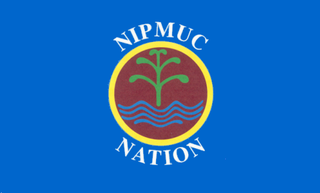
The Nipmuc or Nipmuck people are descendants of the indigenous Algonquian peoples of Nippenet, 'the freshwater pond place', which corresponds to central Massachusetts and immediately adjacent portions of Connecticut and Rhode Island. The English had their first encounter with members of the tribe in 1630, when John Acquittamaug (Nipmuc) took maize to sell to the starving colonists of Boston.
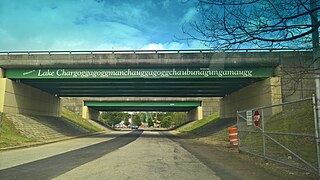
Lake Chaubunagungamaug, also known as Webster Lake, is a lake in the town of Webster, Massachusetts. It is located near the Connecticut border and has a surface area of 1,442 acres. Since 1921, the lake has also been known by a much longer name having 45 letters comprising fourteen syllables: Lake Chargoggagoggmanchauggagoggchaubunagungamaugg. The name attracts many tourists. The lake has become famous beyond Central Massachusetts for having the longest name of any geographic feature in all of the United States.
Indian Country Today (ICT) is a daily digital news platform that covers the Indigenous world, including American Indians, Alaska Natives and First Nations.

Coyote is a mythological character common to many cultures of the indigenous peoples of North America, based on the coyote animal. This character is usually male and is generally anthropomorphic, although he may have some coyote-like physical features such as fur, pointed ears, yellow eyes, a tail and blunt claws. The myths and legends which include Coyote vary widely from culture to culture.
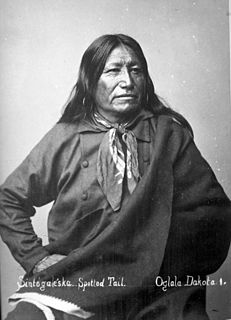
Spotted Tail ; born c. 1823 – died August 5, 1881) was a Brulé Lakota tribal chief. Although a great warrior in his youth, and having taken part in the Grattan massacre, he declined to participate in Red Cloud's War. He had become convinced of the futility of opposing the white incursions into his homeland; he became a statesman, speaking for peace and defending the rights of his tribe.

The Hassanamisco Nipmuc people are part of a larger tribe that identifies itself as the Nipmuc Nation. The Hassanamisco Nipmuc own three and a half acres of reservation land in what is present day Grafton, Massachusetts. This group of indigenous people is native to Central Massachusetts, Northeastern Connecticut, and parts of Rhode Island.
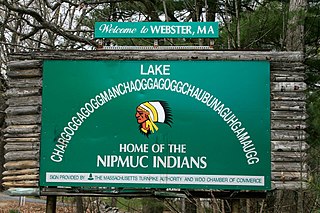
The Webster/Dudley Band of the Chaubunagungamaug Nipmuck Indians, also known as the Chaubunagungamaug, Chaubunagungamaug Nipmuck, Pegan or Dudley Indians, are a Native American tribe indigenous to the U.S. states of Massachusetts and Connecticut in the region of New England. They are one of three tribes with state recognition in Massachusetts as a tribe of Nipmuck Indians, including the Hassanamisco Nipmuc and the Natick Massachusett, although the latter are mainly descended from the Massachusett people.

The Chaubunagungamaug Reservation refers to the small parcel of land located in the town of Thompson, Connecticut, close to the border with the town of Webster, Massachusetts and within the bounds of Lake Chaubunagungamaug to the east and the French River to the west. The reservation is used by the descendants of the Nipmuck Indians of the previous reservation, c. 1682-1869, that existed in the same area, who now identify as the Webster/Dudley Band of the Chaubunagungamaug Nipmuck. Together with the Hassanamisco Nipmuc, both have received state recognition under the Massachusetts Commission on Indian Affairs.
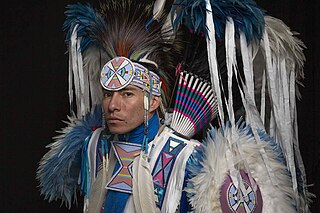
Christian Parrish Takes the Gun, known professionally as Supaman is an Apsáalooke rapper and fancy dancer who was born in Seattle, Washington and grew up in Crow Agency, Montana.

Crow Dog was a Brulé Lakota subchief, born at Horse Stealing Creek, Montana Territory.
Ex parte Crow Dog, 109 U.S. 556 (1883), is a landmark decision of the Supreme Court of the United States that followed the death of one member of a Native American tribe at the hands of another on reservation land. Crow Dog was a member of the Brulé band of the Lakota Sioux. On August 5, 1881 he shot and killed Spotted Tail, a Lakota chief; there are different accounts of the background to the killing. The tribal council dealt with the incident according to Sioux tradition, and Crow Dog paid restitution to the dead man's family. However, the U.S. authorities then prosecuted Crow Dog for murder in a federal court. He was found guilty and sentenced to hang.
More than nine variations of the name have been seen in the records throughout history. In Native American Algonquian language, Quinsigamond is loosely translated as "the pickerel fishing place." Pickerel is a type of fresh water fish commonly native to inland lakes and ponds.
Cheryll Toney Holley is the current chief of the Hassanamisco band of the Nipmuc Nation, a Native American tribe recognized by the state of Massachusetts. She was selected to succeed Chief Walter Vickers after his resignation in July 2013. As chief, Holley's duties range from spiritual advice to job placement assistance. Holley is the tribe's third female chief in the past fifty years. Furthermore, Holley is one of the five founding members of the Nipmuc Women’s Health Coalition. The coalition is run by a group of Native American women advocating for culturally appropriate health care programs for Nipmucs.

Zara Cisco Brough, often spelled as Zara Ciscoe Brough, commonly referred to as Princess White Flower, served as the Chief of the Nipmuc Native Indian Tribe for 25 years from 1962 until 1987. She is best known for her work to preserve Nipmuc heritage, especially her letter of intention to petition for federal recognition of the Nipmuc as a legally distinct Native American people, which resulted in the Nipmuc being placed on "active consideration" for the status of Federally recognized tribe by 11 July 1995.

Wendy Red Star is a Native American contemporary multimedia artist born in Billings, Montana, in the United States. Her humorous approach and use of Native American images from traditional media draw the viewer into her work, while also confronting romanticized representations. She juxtaposes popular depictions of Native Americans with authentic cultural and gender identities. Her work has been described as "funny, brash, and surreal".
John Wompas was a Nipmuc Indian man born around 1637 in Nipmuc Country, in what would become the state of Massachusetts. He spent the first half of his childhood among his Native kin and the second half living with an English family in Roxbury, Massachusetts Bay Colony. This dual upbringing gave him fluency in the languages and customs of both Nipmuc and colonial English worlds. He used his cross-cultural knowledge largely for personal economic and political gain, but at the end of his life he also turned it to the benefit of his Nipmuc kin.
References
- 1 2 3 4 Volain, Mark (20 July 2011). "Two Minutes With Larry Spotted Crow Mann". Worcester Mag. Retrieved 4 April 2013.
- 1 2 3 Sacks, Pamela (12 August 2011). "Webster man keeps Nipmuc tradition alive". Telegraph & Gazette. Retrieved 1 April 2013.
- ↑ ""It's Not Just Native History, it's American History"". Mass Media. 29 November 2011. Retrieved 16 April 2013.
- ↑ Steeves, Gus (16 November 2011). "Earth is not something for you to rip apart". Southbridge Evening News. Retrieved 10 April 2013.
- ↑ Urban, Cori. "Springfield native Larry Spotted Crow Mann authors new book titled 'Tales from the Whispering Basket'" . Retrieved 27 March 2013.
- ↑ Mann, Larry Spotted Crow (5 April 2020). "David Barton's Lies about King Philip's War". Indian Country Today. Archived from the original on 15 April 2013. Retrieved 5 April 2020.
- ↑ Mann, Larry Spotted Crow (16 October 2012). "Native People Are Still Being Misinterpreted and Misunderstood". Indian Country Today Media Network. Retrieved 1 April 2013.
- ↑ Mann, Larry Spotted Crow (10 October 2012). "Last Thoughts on Columbus Day—For This Year, at Least". Indian Country Today Media Network. Archived from the original on 29 March 2017. Retrieved 5 April 2020.
- ↑ Mann, Larry Spotted Crow (23 September 2012). "Mitt Romney Proves Yet Again Just How Out of Touch He Is". Indian Country Today Media Network. Archived from the original on 25 December 2012. Retrieved 5 April 2020.